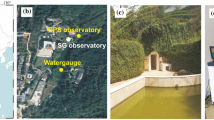Abstract
This paper describes the thermal lag correction for Glider Payload Conductivity Temperature Depth Profiler data with a poor sampling rate. In particular, the thermal lag correction is more vulnerable to the influence of temperature data. According to variations in salinity with depth and the vertical downcast speed of the glider, salinity data are divided into five parts, and a method based on Morison et al. is proposed to determine the correction parameters. At 40–94 dbar and 140–280 dbar, the salinity difference is dominated by the temperature difference. At 94–140 dbar, the salinity difference is immune to the temperature difference and has a greater influence on the thermal lag-induced salinity error correction. After the sectional correction, the accuracy of the typical salinity interval is upgraded from 0.011 to 0.006 psu, which shows the effectiveness of this sectional method on correcting temperature difference.










Similar content being viewed by others
References
Alvarez, A., Stoner, R., & Maguer, A. (2013). Performance of pumped and un-pumped CTDs in an underwater glider. In 2013 Oceans - San Diego (Oceans-Ieee).
Davis, R. E., Kessler, W. S., & Sherman, J. T. (2012). Gliders Measure Western Boundary Current Transport from the South Pacific to the Equator. Journal of Physical Oceanography,42(11), 05.
Di Federico, V., Longo, S., Chiapponi, L., Archetti, R., & Ciriello, V. (2014). Radial gravity currents in vertically graded porous media: Theory and experiments for Newtonian and power-law fluids. Advances in Water Resources,70, 65–76. https://doi.org/10.1016/j.advwatres.2014.04.015.
Eriksen, C. C., Osse, T. J., Light, R. D., Wen, T., Lehman, T. W., Sabin, P. L., et al. (2001). Seaglider: A long-range autonomous underwater vehicle for oceanographic research. IEEE Journal of Oceanic Engineering,26(4), 424–436.
Garau, B., Ruiz, S., Zhang, W. G., Pascual, A., Heslop, E., Kerfoot, J., et al. (2011). Thermal lag correction on Slocum CTD glider data. Journal of Atmospheric and Oceanic Technology,28(9), 1065–1071.
Janzen, C.D., & Creed, E.L. (2011). Physical oceanographic data from Seaglider trials in stratified coastal waters using a new pumped payload CTD. In OCEANS’11 MTS/IEEE KONA, 19-22 Sept. 2011, pp. 1–7. https://doi.org/10.23919/oceans.2011.6107290.
Johnson, G. C., Toole, J. M., & Larson, N. G. (2007). Sensor Corrections for Sea-Bird SBE-41CP and SBE-41 CTDs. Journal of Atmospheric & Oceanic Technology,24(6), 1117–1130.
Liu, Y., Weisberg, R. H., & Lembke, C. (2015). Chapter 17 - Glider Salinity Correction for Unpumped CTD Sensors across a Sharp Thermocline. In Y. Liu, H. Kerkering, & R. H. Weisberg (Eds.), Coastal Ocean Observing Systems (pp. 305–325). Boston: Academic Press.
Liu, Y., Weisberg, R. H., Vignudelli, S., & Mitchum, G. T. (2014). Evaluation of altimetry-derived surface current products using Lagrangian drifter trajectories in the eastern Gulf of Mexico. Journal of Geophysical Research: Oceans,119(5), 2827–2842. https://doi.org/10.1002/2013jc009710.
Longo, S., Di Federico, V., Archetti, R., Chiapponi, L., Ciriello, V., & Ungarish, M. (2013). On the axisymmetric spreading of non-Newtonian power-law gravity currents of time-dependent volume: An experimental and theoretical investigation focused on the inference of rheological parameters. Journal of Non-Newtonian Fluid Mechanics,201, 69–79. https://doi.org/10.1016/j.jnnfm.2013.07.008.
Lueck, R. G. (1990). Thermal Inertia of Conductivity Cells: Theory. Journal of Atmospheric & Oceanic Technology,7(5), 741–755.
Lueck, R. G., & Picklo, J. J. (1990). Thermal Inertia of Conductivity Cells: Observations with a Sea-Bird Cell. Journal of Atmospheric & Oceanic Technology,7(5), 756–768.
Mensah, V., Menn, M. L., & Morel, Y. (2007). Thermal Mass Correction for the Evaluation of Salinity. Journal of Atmospheric & Oceanic Technology,26(3), 665.
Morison, J., Andersen, R., Larson, N., D’Asaro, E., & Boyd, T. (1994). The Correction for Thermal-Lag Effects in Sea-Bird CTD Data. Journal of Atmospheric & Oceanic Technology,11(11), 1151–1164. https://doi.org/10.1175/1520-0426(1994)011%3c1151:TCFTLE%3e2.0.CO;2.
Rudnick, D. L., Davis, R. E., Eriksen, C. C., Fratantoni, D. M., & Perry, M. J. (2004). Underwater gliders for ocean research. Marine Technology Society Journal,38(2), 73–84.
Rudnick, D. L., Sherman, J. T., & Wu, A. P. (2018). Depth-Average Velocity from Spray Underwater Gliders. Journal of Atmospheric and Oceanic Technology,35(8), 1665–1673. https://doi.org/10.1175/jtech-d-17-0200.1.
Schmitt, R. W., & Petitt, R. A. (2006). A fast response, stable CTD for gliders and AUVs. In Oceans, (pp. 1–5).
Sherman, J., Davis, R. E., Owens, W. B., & Valdes, J. (2001). The autonomous underwater glider “Spray”. IEEE Journal of Oceanic Engineering,26(4), 437–446.
Todd, R. E., Rudnick, D. L., & Davis, R. E. (2009). Monitoring the greater San Pedro Bay region using autonomous underwater gliders during fall of 2006. Journal of Geophysical Research: Oceans, 114(C6).
UNESCO. (1981). Tent report of the Joint Panel on Oceanographic Tables and Standards. UNESCO Tech. Papers in Marine Science 36, 24 pp.
Webb, D. C., Simonetti, P. J., & Jones, C. P. (2001). SLOCUM: An underwater glider propelled by environmental energy. Journal of Ocean Engineering,26(4), 447–452.
Yu, J.-C., Zhang, A. Q., Jin, W. M., Chen, Q., Tian, Y., & Liu, C. J. (2011). Development and experiments of the sea-wing underwater glider. China Ocean Engineering,25(4), 721–736.
Acknowledgements
This work was supported by the Shenyang Institute of Automation, Chinese Academy of Sciences; we thank the crews for acquiring the numerous data used in this study. The authors would like to thank the National Key R&D Program of China (2016YFC0301203) and National Natural Science Foundation of China (41576060) for their support in this research.
Author information
Authors and Affiliations
Corresponding author
Additional information
Publisher's Note
Springer Nature remains neutral with regard to jurisdictional claims in published maps and institutional affiliations.
Rights and permissions
About this article
Cite this article
Chu, F., Si, Z., Pang, C. et al. Thermal Lag Correction From a GLIDER Payload CTD for Poor Temperature Data. Pure Appl. Geophys. 177, 3039–3051 (2020). https://doi.org/10.1007/s00024-019-02359-1
Received:
Revised:
Accepted:
Published:
Issue Date:
DOI: https://doi.org/10.1007/s00024-019-02359-1




